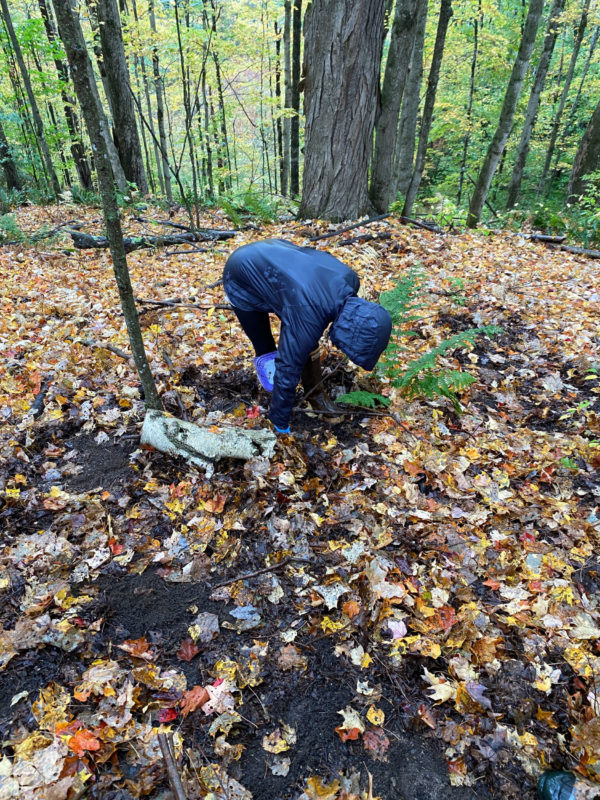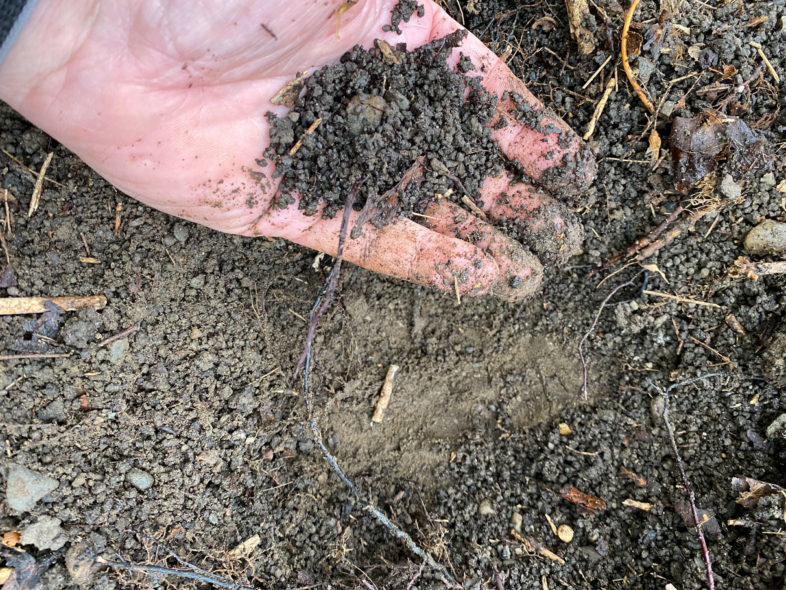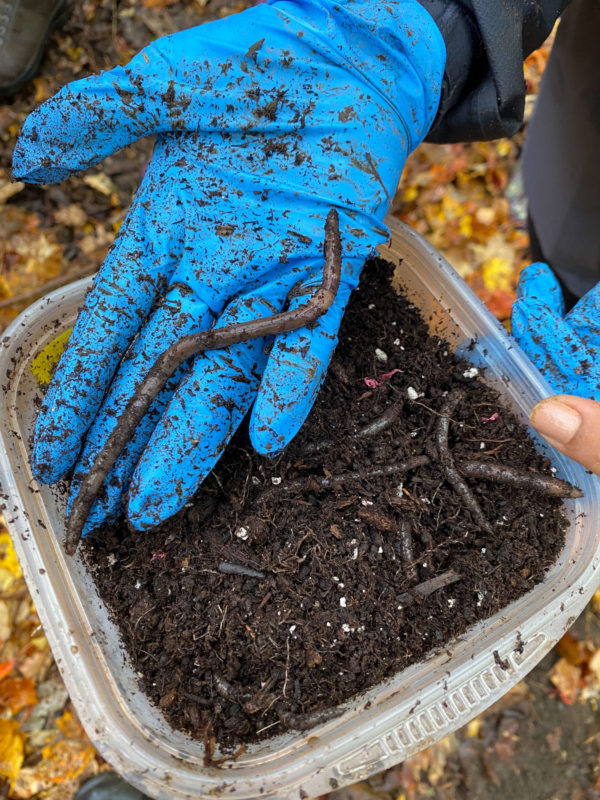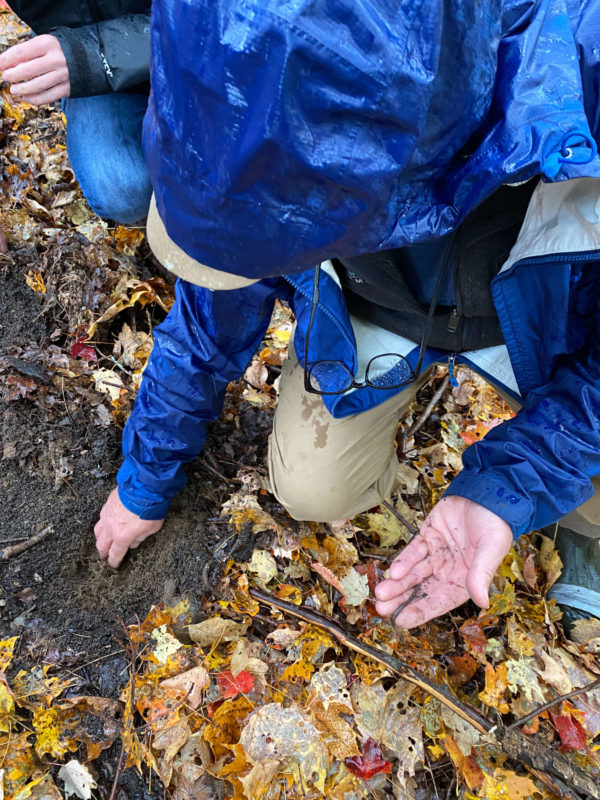Jumping worms, AKA crazy worms, jumpers or snake worms, are invasive earthworms recently found in Vermont. Currently there are three species of jumping worms introduced from Asia that appear to threaten northeastern hardwood forests: Amynthas agrestis, Amynthas tokioensis and Metaphire hilgendorfi. Jumping worms get their name from their behavior. When handled, they violently thrash, spring into the air and can even shed their tails to escape. In the forests of North America, these voracious feeders eat the organic layer on the surface of the forest floor, which hampers the growth of tree seedlings and many understory plants.
Vermont was completely covered by glacial ice about 12,000 years ago, which removed any native earthworms which may have evolved with these forests. Today, earthworms found in the Northeast are mainly exotic species. Many were introduced in the 18th and 19th centuries via European settlers and soil and horticultural materials transported from Europe and Asia. New species are continuing to be introduced and spread across the landscape through fishing bait, compost and the horticulture industry.
These introduced earthworms pose an ecosystem health threat to Vermont forests. They consume the organic top (duff) layers of soil, which causes cascading effects to native biodiversity. Duff is important for nutrient exchange networks involving fungi mycelium and plant roots. It is also where many seeds germinate. The change in forest floor structure reduces plant diversity and affects other species such as ground nesting birds, small mammals, invertebrates, and woodland salamanders.
In this episode of Outdoor Radio, hosts Kent McFarland and Sara Zahendra are at the Green Mountain Audubon Center in Huntington, Vermont. They are joined by Mark Labarr, Conservation Program Manager for the Green Mountain Audubon Center, Dr. Josef Görres, from the Plant and Soil Science department at UVM and a graduate student studying the snake worm, Maryam Nouri-Aiin. Join them as they search the forest floor, in the rain, looking for invasive species of worms.
Listen to the Show
Learn More
- Earthworms in Vermont forests report from VT Forest, Parks and Recreation and UVM study.
- If you find jumping worms, take photos and add them to the Vermont Atlas of Life on iNaturlalist.
- View an interactive map of locations where they have been reported to the Atlas.
- Jumping Worm information and identification card from WI DNR
- Illustrated key to Canada earthworms
- Invasive Earthworms in Northeastern Sugarbushes – slide deck presentation
More Images from the Show

Dr. Josef Görres, Sara Zahendra, Maryam Nouri-Aiin, Mark Labarr, and Kent McFarland (left to right) dripping rain after searching the forest floor for worms. © Chris Albertine

Maryam Nouri-Aiin exposes the worm castings under the newly fallen leaves while searching for jumping worms. © Kent McFarland

A closeup of the coffee ground like castings from the jumping worms scraped from the top of the soil. © Kent McFarland
Outdoor Radio is produced in collaboration with Vermont Public Radio.
Comments (8)
Pingbacks (1)
-
[…] Join them as they search the forest floor, in the rain, looking for invasive species of worms.” Link […]



Last week I found jumping worms in woods behind my home on Garbrooke Drive, in BENNINGTON, Vt. There is a large area of them. I have a flower and vegetable garden nearby which seems clear of these worms as of yesterday. I am reporting this here as the first place I found to do so.
I have photos of the worms as well as a photo of the surrounding area. I need information where to report this in Vermont.
Hi Virginia, YOu can report that to our project called the Vermont Atlas of Life on iNaturalist. Just take some photos and upload your observation at https://www.inaturalist.org/projects/vermont-atlas-of-life. Or, you can email me the exact location, images and date found and I can add it. Thanks! Kent McFarland
I know I have these in my garden… I just thought they were crazy worms…will take pics tomorrow & report these…Hubbardton
I am concerned about the impact these worms are likely having on the woods in Vermont. Is there anything we can do to control, or mitigate the effect of these worms once they are present?
The best control is of course preventing them from being introduced to areas. Once they are there, it is apparently quite difficult to control them. But, there is ongoing research at UVM into ways to manage them in Dr. Gorres lab there using a fungus that attacks them. https://www.uvm.edu/cals/pss/profiles/associate-professor-josef-gorres
Hi, I’m not sure how to add my 2nd encounter with a Jumping worm.
1st we found one in our compost pile. Not realizing how invasive the are I threw it back into the weeds. I am now very sorry I did.
Yesterday I found one in my vegetable garden and am very worried.
I will now start drowning them in a bucket of water.
Once dead can I then compost them?
It is probably best to add your observations to iNaturalist.org. Here are some other resources that might help –
https://www.alleghenyfront.org/how-to-prevent-invasive-asian-jumping-worms-from-ruining-your-garden/
https://extension.umd.edu/resource/invasive-jumping-worms#:~:text=The%20best%20way%20to%20manage,There%20are%20no%20chemical%20controls.
and there are many more online too.
This is a report: On Sept. 11, 2023, I found invasive jumping worms in my outdoor uncovered compost pile, at 2306 Taplin Hill Road, Corinth, Vermont. I removed most of them. When will it be safe to use the compost in my gardens?